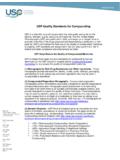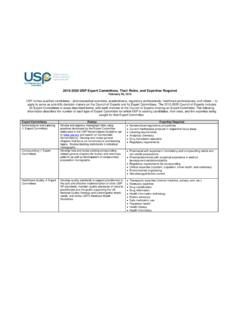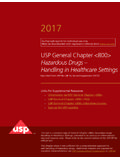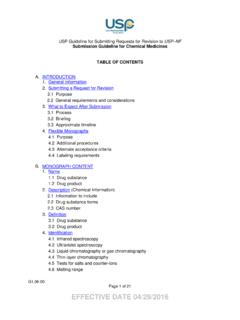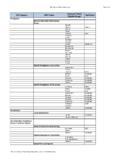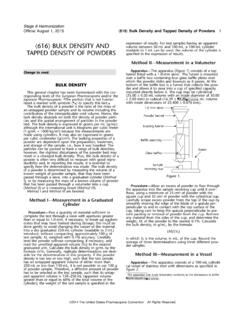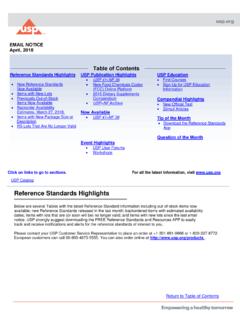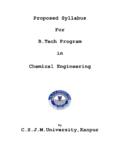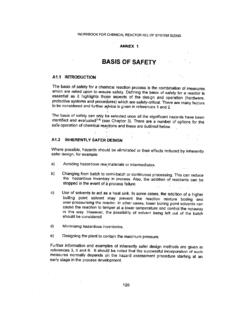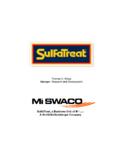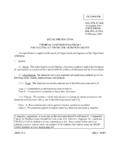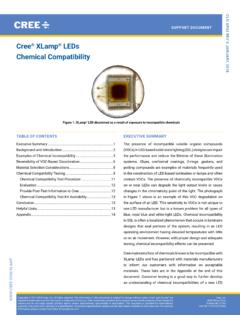Transcription of á232ñ ELEMENTAL IMPURITIES—LIMITS
1 Table 10 (Continued)Standard SolutionConcentration of Neu5Ac after Labeling(mM)Concentration of Neu5Gc after Labeling(mM) solution:Transfer a desalted sample containing approximately 50 mg of protein (equivalent to about 5 pmolof sialic acid) into a microcentrifuge tube. Dry in a vacuum centrifuge without heating. Add 25 mL of 2M aceticacid into the tube and briefly centrifuge to ensure all of the sample is in the well of the tube. Incubate at 80 for 2 h 15min. [NOTE Or use validated sample preparation and time/temperature ranges.]
2 ] Allow the tube to cool to room temper-ature for approximately 10 min. Then vortex and centrifuge. Label the solution as directed in Labeling before analysis. USP REFERENCE STANDARDS 11 USP N-Acetylneuraminic Acid RSUSP N-Glycolylneuraminic Acid RSUSP KDN RS3-Deoxy-D-glycero-D-galacto-2-nonuloso nic (USP40) 232 ELEMENTAL IMPURITIES LIMITSC hange to read:INTRODUCTIONThis chapter specifies limits for the amounts of ELEMENTAL impurities in drug products. Regardless of the approach used,compliance with the limits specified is required for all drug products unless otherwise specified in an individual monograph orspecifically excluded in this (USP40) ELEMENTAL impurities include catalysts and environmental contaminants that may be present in drug substances, excipients,or drug products.
3 These impurities may occur naturally, be added intentionally, or be introduced inadvertently ( , by inter-actions with processing equipment and the container closure system). When ELEMENTAL impurities are known to be present,have been added, or have the potential for introduction, assurance of compliance to the specified levels is required. A risk-based control strategy may be appropriate when analysts determine how to assure compliance with this standard. Due to theubiquitous nature of arsenic, cadmium, lead, and mercury, they (at the minimum) must be considered in the risk chapter does not apply to.
4 Radiopharmaceuticals Articles intended only for veterinary use Vaccines Cell metabolites DNA products Allergenic extracts Cells, whole blood, cellular blood components, or blood derivatives, including plasma and plasma derivatives Products based on genes (gene therapy) Cells (cell therapy) Tissue (tissue engineering) Dialysate solutions not intended for systemic circulation Total parenteral nutritions (TPNs) Elements that are intentionally included in the drug product for therapeutic benefit Dietary supplements and their ingredients, which are addressed in ELEMENTAL Contaminants in Dietary Supplements 2232 1S(USP40)The limits presented in this chapter do not apply to excipients and drug substances, except where specified in an individualmonograph.
5 However, manufacturers of pharmaceutical products need certain information about the content of elementalimpurities in drug substances or excipients in order to meet the criteria of this chapter. Drug product manufacturers can useelemental impurity test data on components from tests performed by drug substance or excipient manufacturers, who mayprovide test data, or if applicable, risk assessments. ELEMENTAL impurity data generated by a qualified supplier of drug productcomponents are acceptable for use by a drug product manufacturer to demonstrate compliance with this chapter in the finaldrug product.
6 Drug substance or excipient manufacturers who choose to perform a risk assessment must conduct that riskassessment using Table 2 in this chapter. Elements that are inherent in the nature of the material, as in the case of some natu-rally-sourced materials, must be considered in the risk (USP40)First Supplement to USP 40 NF 35 Chemical Tests / 232 ELEMENTAL Impurities Limits 8065 Official from December 1, 2017 Copyright (c) 2017 The United States Pharmacopeial Convention. All rights from by uspstaff on Tue Oct 24 10:21:13 EDT 2017 SPECIATIONThe determination of the oxidation state, organic complex, or combination is termed speciation.
7 Each of the elementalimpurities has the potential to be present in differing oxidation or complexation states. However, arsenic and mercury are ofparticular concern because of the differing toxicities of their inorganic and complexed organic arsenic limits are based on the inorganic (most toxic) form. Arsenic can be measured using a total-arsenic procedureunder the assumption that all arsenic contained in the material under test is in the inorganic form. Where the limit is exceededusing a total-arsenic procedure, it may be possible to show, via a procedure that quantifies the different forms, that the inor-ganic form meets the mercury limits are based upon the inorganic (2+) oxidation state.
8 The methyl mercury form (most toxic) is rarely an issuefor pharmaceuticals. Thus, the limit was established assuming the most common (mercuric) inorganic form. Limits for articlesthat have the potential to contain methyl mercury ( , materials derived from fish) are to be provided in the to read:ROUTES OF EXPOSUREThe elements included in the tables below have been placed into three classes, based on their toxicity and likelihood ofoccurrence in the drug product. The classification scheme is intended to focus the risk assessment on those elements that arethe most toxic but also have a reasonable probability of inclusion in the drug product (see Table 2).
9 1S(USP40)The toxicity of an ELEMENTAL impurity is related to its extent of exposure (bioavailability). The extent of exposure has beendetermined for each of the ELEMENTAL impurities of interest for three routes of administration: oral, parenteral, and limits are based on chronic exposure. Consider the oral permissible daily exposures (PDEs) in Table 1 as a starting pointin developing specific PDEs for other routes of administration, except where otherwise stated in the individual monograph.[NOTE The routes of administration of drug products are defined in Pharmaceutical Dosage Forms 1151.]
10 ]Change to read:DRUG PRODUCTSThe limits described in the third1S(USP40) through fifth1S(USP40) columns of Table 1 are the base daily dose PDEs of theelemental impurities of interest for a drug product taken by a patient according to indicated routes of ProductsParenteral drug products with maximum daily volumes up to 2 L may use the maximum daily volume to calculate permissi-ble concentrations from PDEs. For products whose daily volumes, as specified by labeling and/or established by clinical prac-tice, may exceed 2 L ( , saline, dextrose, 1S(USP40) and solutions for irrigation), a 2-L volume may be used to calculate per-missible concentrations from 1.

